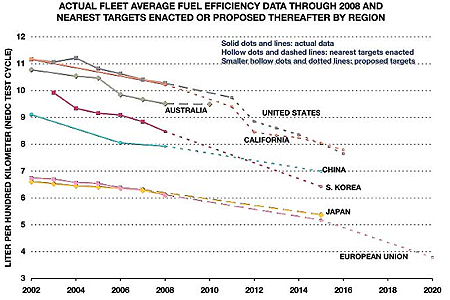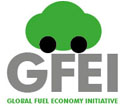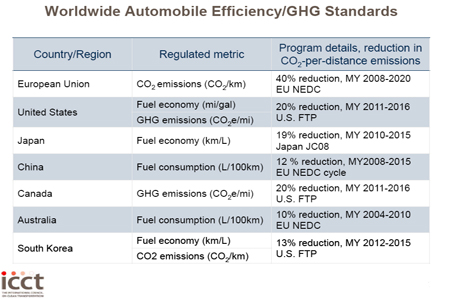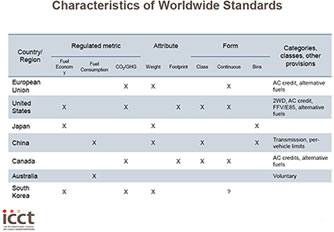
National Standards
Setting standards
Detailed case studies
Auto fuel economy standards are an important part of the fuel economy policy package, particularly in countries that have an auto manufacturing industry. Standards help to increase regulatory certainty for manufacturers faced with long investment cycles, enabling them to bring new technology to market. In addition, research shows that fuel economy mandatory standards enable greater greenhouse gas emission reductions (on average 2-3% per year) than voluntary systems (on average 0-1% reductions per year). Regulation and standard-setting is a powerful tool in reducing emissions and cleaning up transport. Regulatory certainty also facilitates the development of advanced technology. However, very few countries outside the OECD have developed fuel economy policies, standards and regulations.
A note on countries without an auto manufacturing industry: Fuel economy standards are most appropriate in countries with vehicle manufacturing and large markets that have the potential to influence the type of vehicles developed and brought to market. In small market countries, however, particularly those without vehicle manufacturers, a fuel economy standard may not be the most appropriate policy measure to improve the fuel efficiency of the vehicle fleet.
One reason is that non-manufacturing and small countries have less technical capacity to test vehicles to verify manufacturer fuel economy ratings in local conditions (see test cycles), and therefore, will have difficulty developing and enforcing any fuel economy standards. A fiscal measure (e.g. a feebate) with an accompanying vehicle labeling scheme would be simpler to implement and administer in import-based markets. Even though testing is required to establish vehicle labels, countries could use an existing certification system (i.e. from a major neighboring market, such as the EU or Japan) to provide labels for each vehicle sold. New Zealand is a good example of an importing market that uses EU and Japanese certification systems to label vehicles imported into the national market.
Another reason is that non-manufacturing countries tend to be ‘technology takers’ and may have little influence on the vehicle technologies developed by manufacturers. The main advantage of fuel efficiency standards is to allow manufacturers to make a mid- or long-term plan for research, development and production decisions. A small country and one without manufacturers is not likely to drive technology decisions and product development strategies for manufacturers. There is even a risk that manufacturers will pull products from the market in small countries rather than adapt to the standards set by these small markets. However, well-designed fuel economy standards may still be worthwhile to ensure that imported vehicles at least meet a minimum threshold of fuel economy performance.
Setting Standards
If/once a decision has been made to formulate fuel economy standards for light vehicles, the next step for policymakers is to decide the category of vehicles for which standards are to be developed. Historically, fuel economy standards have been developed for light vehicles, but fuel economy standards for two and three wheelers as well as heavy commercial vehicles and buses exist, and different countries may choose to formulate standards for these categories of vehicles first instead of light vehicles. Light vehicles include all passenger vehicles including cars, sport utility vehicles, minivans as well as light commercial vehicles/vans. For type approval purposes these are often denoted as M1 and N1 vehicles respectively with gross vehicle weight of less than 3500kg. However, larger/heavier vehicles falling in M2 category (gross vehicle weight less than 5000 kg) could be considered as well.
At this stage policymakers must evaluate the alternatives forms of standard as well as availability of data to formulate the actual standard. While standard development requires comprehensive data on vehicle attributes and sales, initial efforts should be focused on developing a conceptual framework of the standards. The conceptual design of the standard will drive the longer-term evolution of vehicle technology and manufacturers’ response to the standards, and thus should be evaluated carefully. While actual standard development requires comprehensive data on new vehicle attributes and sales, initial efforts should be focused on conceptual framework of the standards. The conceptual design of the standard will drive the longer-term evolution of vehicle technology and manufacturers response to the standards, and thus should be evaluated carefully. A framework for developing fuel economy standards is described below, but these steps are neither comprehensive nor to be followed in a linear fashion. Each country context will drive the policy process at the national level in different ways.
The following are common design elements of an auto fuel economy standard:
- Identification of primary piece of legislation and department or agency of the government responsible for formulating and ensuring compliance with the standards.
- Choice of regulated metric: Two primary concerns have prompted governments around the world to implement standards related to the fuel consumption of motor vehicles. The first reason is the concern for growing use of petroleum, security of supply, as well as energy prices. The second is the concern about climate change resulting from CO2 emissions, which are created as a result of combustion of fossil fuels used to operate motor vehicles. In general, concerns about petroleum use and energy security have prompted adoption of fuel economy standards as measured in kilometers per liter (km/l) or miles per gallon (mpg). On the other hand, when climate change was the primary driver, a greenhouse gas emission based standard (g CO2equivalent/km or g CO2equivalent /mile) was adopted. Unless greenhouse gases other than CO2, such as methane and N2O, are included, fuel economy and CO2 emission standards are equivalent.
- Limit value or corporate average standards: Under a per vehicle compliance scheme or limit value approach, each vehicle model in its weight class must meet the class fuel economy standard. This approach ensures a minimum fuel economy level for each weight class regardless of the sales data. Under such an approach, compliance is achieved before sale of a vehicle, and non-compliant vehicles have to remain out of the market. This approach was adopted by China in Phase I and II of fuel consumption standards. Under a corporate average compliance, the sales weighted fuel consumption of any vehicle manufacturer must be less that the sales weighted average of the standard that the vehicle manufacturer is subject to in that model year. Under a corporate average compliance, vehicle manufacturer can decide the most convenient schedule for improving individual vehicle model fuel economy while still meeting the overall fuel economy improvement target. Presently, all countries that have adopted a fuel economy standard follow this approach including China phase III standards.
Almost all countries now use a corporate average instead of minimum value standards because fleet averaging offers a greater incentive to improve across models, whereas there is no incentive to improve vehicles that already comply with a minimum value standard. In addition, fleet averaging allows greater flexibility for automakers to sell a diverse fleet of vehicles. Among fleet average standards, some countries use a single standard that the entire fleet must comply with. Other standards use an attribute of the vehicle to differentiate, with the standard varying according to either weight of the vehicle or footprint (size).
- Form of the standard: The fuel efficiency standards could be set as a single value (flat corporate average standard), or as a function of a vehicle attribute. If the standards are based on an attribute, then the standards could be a continuous function as is the case in Europe and United States or they could be a step function that varies according to class, as is the case in Japan and China.
- Choice of attribute: A flat standard i.e. a single numerical target that all manufacturers have to meet on a corporate average basis would be a simpler design choice. A flat standard fully incentivizes a range of technology options including vehicle light-weighting as well as vehicle downsizing to meet the CO2 standard. An attribute-based standard (e.g. vehicle weight) is preferred by many as a means to a more equitable distribution of responsibility. Some manufacturers, typically those who specialize in producing vehicles of larger size, view flat standards as a competitive disadvantage, and can see their burden lessened by use of an attribute-based standard. In addition, attribute based standards ensure that vehicles across all fleet have to deploy newer technology since the standards cannot be met alone simply by selling smaller cars. Footprint indexed standards, which are used in the United States, have several important advantages over mass indexed standards for encouraging the significant benefits of mass reduction.
Under a weight-based standard, engine downsizing improves efficiency but also reduces vehicle weight, in doing so exposing it to a stricter standard. The way the standard varies according to weight (the slope of the differentiation curve) can be adjusted to put more or less pressure on heavier vehicles to improve fuel economy. Weight-based standards provide fewer strategy options for automakers to use technology and fleet composition shifts to comply with standards.
- Target year for standards: Manufactures need to be provided with a two to three year lead-time to prepare for near-term targets. Standards with longer lead-time can be progressively more stringent since manufacturers have adequate time in such cases to adjust design cycles of new products with anticipated standards. Given the long-life of modern automobiles, even small near-term improvements will have a lasting impact on reducing both fuel consumption and greenhouse gas (GHG) emissions. Standards can be set for each subsequent year after the first target year (as is the case in US) or for specific target years (as in case of Europe or Japan). Even if specific target years are chosen, compliance with the standards can be required in the intermediate years through a phase-in requirement (as in case of Europe and South Korea).
- Single set of target for all light vehicles: The best practice in setting light-vehicle CO2 standards would likely be a single standard for all light vehicles (M1 and N1 combined). If M1 (Cars and SUVs) and N1 (pick-up trucks and other goods carriers) standards are separated, there may be a tendency to reclassify some of the larger/heavier/less efficient Cars and SUVs as utility vehicles through simple design changes without affecting the underlying engine/transmission or overall utility of the vehicle. Combining the standards into one may provide a disadvantage to some of these vehicles, especially if the standard is not attribute based. Under an attribute-based standard, however, consideration can be given to the larger size/mass of the trucks while maintaining one set of standards for M1 and N1 vehicles. At present, no country regulates all M1 and N1 vehicles under the same standard. At the same time, there is recognition that technologies available to reduce CO2 emissions of light-vehicles are similar.
- Stringency of standards: The stringency of standards could be determined on the basis of either a technology assessment or a best-in-class approach.
a. Technology assessment to evaluate the impact of incorporating new technology to improve vehicle fuel economy: The fuel consumption reduction from additional vehicle technology is evaluated and then combinations of technologies in vehicle packages are assessed for the overall potential to reduce vehicle fuel consumption. Such an evaluation will require extensive data collection and vehicle modeling exercise, and is most useful for setting long term target. As of date, the supporting documents released by the U.S. EPA for the 2017-2025 Light-Duty Vehicle GHG Standards proposal are the most recent and up-to-date information on costs and benefits of standards.
b. Best-in-class vehicles already available in the fleet at present: Vehicles leading their respective weight/size-class or market segment in terms of fuel economy are termed as front-runner or top-runner vehicles. Fuel economy standards can be designed with the goal of improving the average fuel economy in target year beyond the fuel economy of best-in-class vehicles. This type of approach is especially useful in setting the stringency of near-term standards, since the standard target is shown to be achievable by actual vehicles in the market at present.
- Derogation for small volume and niche manufacturers may be considered since the limited volume or market niche may not allow some of these manufacturers to meet a standard designed for most major manufacturers.
- Test Procedures: Appropriate test procedures, consistent with the test procedure used to measure air pollutants, should be used to measure, report and verify fuel economy of light vehicles. Test groups should be defined carefully to ensure that fuel economy of the vehicles being tested is truly representative of the fuel economy of model variants sold in the market.
- Administrative Protocol: Appropriate protocols should be devised for collection, as well as sharing of test data, and vehicle sales as well as for monitoring compliance between concerned government agencies. An important part of this is to determine the legal entities responsible for complying with the standards. This is especially important in countries where large fraction of vehicles offered for sale is imported.
- Flexibility Mechanisms: Averaging, banking and trading, coupled with annual targets, can improve the cost-effectiveness of a given target. These flexibility mechanisms facilitate the implementation of the most cost-effective technologies, provide a greater incentive to improve emissions over the full spectrum of vehicles sold, and allow for more rapid progress towards emissions reduction goals. If not coupled with annual targets, banking of credits can severely erode the overall program benefits.
- Penalties for non-compliance: Penalties for non-compliance are an important part of ensuring that the CO2 reduction goals of the regulation are eventually met. It is important to set financial penalties at a level high enough to provide a strong incentive to comply with the standard rather than simply pay the penalty. In other words, the penalties should be higher than the cost of technology required to reduce CO2 emissions in order to make compliance the more cost-effective option.
Over 75% of the world light duty market has fuel economy, fuel consumption, or carbon dioxide (CO2) standards. Standards for the world’s largest markets are summarized in the table below. Fuel economy or CO2 emissions standards are an effective way of overcoming the natural aversion to investing in fuel economy that result from the inherent instability of oil prices.
There are a range of approaches to standard setting across countries, and target rates of fuel economy improvement may differ, but all have the same goal of promoting more efficient new cars.
Credit: International Council on Clean Transportation, Anup Bandivadekar, May 5th 2010, http://www.50by50campaign.org
Credit: International Council on Clean Transportation, Anup Bandivadekar, May 5th 2010, http://www.50by50campaign.org
The International Council on Clean Transport (ICCT) summarises the fuel economy standards in place and under development for selected countries around the world - making adjustments for differences in fuel economy test cycles in different countries. The standards currently in place cover a relatively short period of time, none extending beyond 2016. It will be important that standards are renewed and tightened in order to keep fuel economy improving.

Detailed case studies:
European Union
United States
South Africa
Chile
India
Japan
Japan
In Japan, fuel efficiency standards are developed using the “Top Runner” method. Standards are determined based on the vehicles whose performance is currently the best in the weight class (plus an escalation factor), with a lag time for other vehicles to improve to current best practice. This system was first introduced in 1999 for light duty vehicles (passenger cars and commercial vans). The standards required a 19% improvement in fuel economy by 2010 (in L/100km; equal to a 23% increase in Km/L). In 2007, additional standards were introduced which require a similar 19% improvement in L/100km (24% increase in Km/L) between 2004 and 2015.
Among non-OECD countries, only China currently has fuel economy standards. As an increasing number and share of new vehicles will be sold in the developing world over the coming decades, it will be important for rapidly developing countries to establish their own fuel economy regulatory systems.
*This information is based on guidance and research from the International Council on Clean Transportation.









